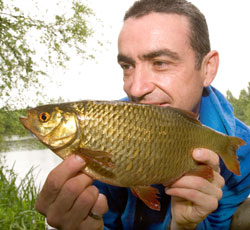With flanks of soft burnished gold and blood red fins, the rudd is surely one of the most strikingly beautiful fish in the UK. But sadly, like the crucian carp, it is far less common than it once was. Stocking policies geared towards carp have seen rudd pushed out of many fisheries; thankfully, however, there are strongholds throughout the country, with particularly buoyant populations throughout Cambridgeshire and East Anglia.
Elsewhere, distribution is a little on the patchy side, but there are plenty of pockets of good rudd fishing to be found, and I have had successes in venues as diverse as southern estate lakes to North Yorkshire clay pits!
And the good news for all of us is that recent developments in commercial fishery management have seen increasing numbers of rudd stocked – so there has never been a better time to bag yourself a golden wonder!
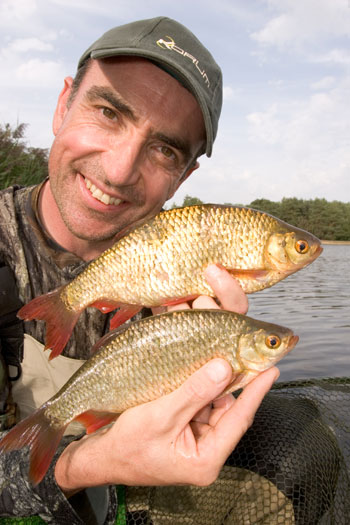 The venue for my session today is not an estate lake or a clay pit, but the delightful Frensham Small Pond, a sprawling 30-acre shallow and reed-fringed sand-pit in the heart of rural Surrey.
The venue for my session today is not an estate lake or a clay pit, but the delightful Frensham Small Pond, a sprawling 30-acre shallow and reed-fringed sand-pit in the heart of rural Surrey.
The Pond is situated in an area of outstanding beauty owned by the National Trust with angling controlled by the Farnham Angling Society. It has produced rudd to well over the 2lb mark and a catch of smaller specimens is always on the cards.
The only downside of the venue is that the sandy ‘beaches’ attract dog walkers, sunbathers, picnickers, swimmers, birders, boaters and horse riders. It can at times seem like fishing off Blackpool Pleasure Beach, but the rudd don’t seem to mind!
With very shallow margins the only effective way to tackle the Frensham rudd is to wade toward the slightly deeper water, and after I’ve pulled on my chest waders the first job is to get myself organised so everything is to hand. Front and rear rod rests are positioned carefully and to my side a Korum table holds my hook baits along with spare hooks, shot, catty and disgorger. To the other side my keepnet acts as a rest for my landing net and I’m using a Preston up and over pole rest to anchor my bucket of loose feed – not what it’s designed for, but it stops the feed floating away if the waves get up! Organisation is essential if fishing in the water and the last thing I want to do is keep disturbing both the swim and my fishing rhythm by constantly wading back to the shore for bits I’ve forgotten!
A quick look at the pictures in this issue’s species guide will tell you straight away where you are likely to find rudd; that upturned mouth betrays a fish which likes to feed off the top and up in the water.
Rudd cruise the upper water layers in shoals picking off insects and are most comfortable close to cover, such as reeds, although they may be found in open water if the food is there. A light breeze is great for the rudd hunter as it carries with it floating bugs, flies and insects, and the fish are never too far away – sipping at the surface and intercepting anything falling onto, or through, the water.
There’s a wind today so I’ve set up station at the windward end of the lake with the breeze blowing into me; if rudd are on the move they should be drifting my way following the invertebrate flotsam – and I’ll be here waiting to intercept them.
For fishing on the drop I favour the loaded Drennan Puddle Chucker floats, their clear bodies offering advantages for up-in-the-water fishing in shallow areas and the interchangeable weighted bases affording great versatility. I’m starting with a 3 x No4 model that has a fine insert tip, which will show the most delicate of bites without undue resistance, but I’ll switch to a heavier pattern with a solid tip for increased stability and visibility if the wind gets up.
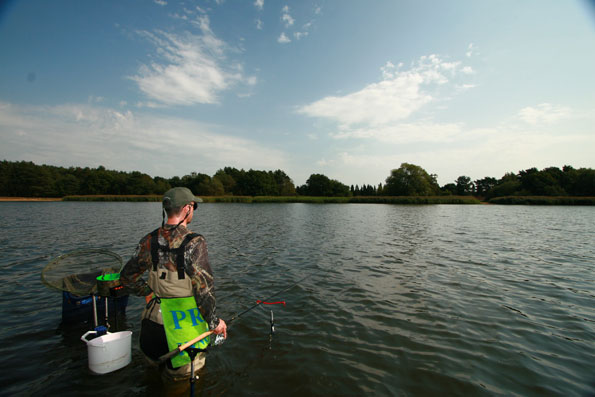
Shotting is very simple. I’m going to use a plummet to set the float at the lake depth and lock it in place with a couple of Fox braid stops; these grip perfectly, even on fine mono, and allow for quick and easy depth changes if required. To ensure my hook bait falls evenly through the water I’m using micro shot with No10s spaced evenly down the line, with one every three to four inches. This pattern gives a more natural drop through the water column than a smaller number of larger shot.
Plan B, if I’m plagued with numbers of very small rudd, is to increase my shot size to No4 or No6 with a bulk shotting well down and a single No8 dropper just above the hook. This will get my hook bait down through the smaller fish more quickly, and keep it there.
Watch a match angler working their shotting patterns and you will realise just how much of an art it can be, just a small change making all the difference between bites and no bites. I’m a pleasure and big fish angler, not a Tommy Pickering or Des Shipp, but I will experiment with my shotting throughout the course of a session until I find what is going to work.
Despite the name, stillwaters are frequently far from ‘still’ with wind patterns on larger waters often kicking up a considerable underwater flow or undertow. This colours the water, kicks all sorts of food items into suspension and can stimulate feeding behaviour. However, hook baits skittering un-naturally across the bottom beneath moving floats do not encourage positive feeding so I’ll be looking out for this. To counteract the problem I’ll move my float up a couple of inches so it is fishing slightly overdepth, and drop another shot closer to the hook to act as an anchor.
Delicate shotting patterns and light lines can cause problems in a stiff breeze or when chucking a fair distance, so to avoid tangles I’m going to be feathering my casts. This simply involves touching the line against the spool just before touchdown to slow down the flight of the float. As the float slows the line, the shot below it straightens out and falls flat across the water rather than in a heap beneath the float! It’s worth practising, as on-the-drop fishing demands a very regular casting regime!
Fishing for rudd on the drop requires a constant fall of feed through the water, so my catty is going to get a bit of stick today! I know there are large numbers of small fish in the water, so I’m keeping away from maggots and casters, and using corn. A small pouchful sprayed over the target area every cast creates an area of attraction, and it’s not long before my float dips and I’m into a rudd of a couple of ounces.
I’m not allowing the float to settle for too long – this is not a rig to be cast and left, so every 30 seconds, bite or not, I recast and allow the hook bait to drop through the water again.
It’s clear there are vast numbers of fish in front of me and every cast brings the same result, the float usually sliding away as soon as it hits the surface. It’s clear, however, that there are so many small fish in front of me and I’m not getting through them effectively, so I switch from corn loose feed to hemp and 4mm Marine Halibut pellets in an effort to ‘feed off’ the small fish.
It takes a while before the better fish move in and it’s not long before the average stamp is around the 8oz mark with the occasional better one. That’s more like it – a decent bag of fish is on the cards!
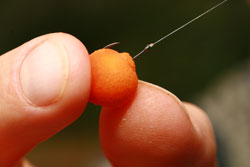 |
|
A change to a mini boilie brought much bigger fish. |
A change to a mini boilie hook bait with the shot set lower down the line slows the action enough for me to have a breather. The first bite brings the solid thump of a good rudd and the first fish over the pound mark is in the net. As usual, the better rudd are holding station a little deeper, waiting to pick off any offerings missed by their smaller brethren. A cast just in front of, or behind, the main baited patch can often catch out one of the better fish, too, so every little while I drop a cast short to work the area.
The second bite on a mini boilie brings a much more solid fish, but as the clutch screams I soon realise I’m into a tench. With balanced tackle it’s not a problem to handle in open water, and I’m soon returning it and getting back to the rudd. The wind is picking up and causing considerable water movement, so I further slide up the float and anchor the bait to counteract it.
An ominous scattering of fish in front of me, followed by an airborne pike display, signals the beginning of the end, though. Every time I get the shoal feeding confidently the snapper piles in – and he’s brought his mates with him – there are predators everywhere, and the rudd will just not settle and feed confidently.
I manage another couple of bigger fish by casting just off the main area of feed, but when the best fish of the day – a possible two-pounder – is snatched on the way to the net my only real choice is to move swims and start again.
The change works briefly, but once again, as soon as I have a shoal of fish feeding, the pike move in, resembling dolphins herding a shoal of sardines. I’ve put together a couple of nets of quality rudd, but today the pike have got the better of me and it’s home for an early bath.
Loadsa Loosefeed
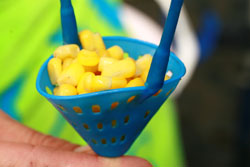 |
1 To attract the bigger rudd into the swim Ian feeds corn.
2 But there are so many small fish he switches to hemp…
3 …and 4mm Marine Halibut pellets to ‘feed them off’.
Preparing Mini Boilie Hook Baits
Rudd love boilies, but to maximise your chances of hitting bites it is essential to soften them, and Ian does this by soaking them in lake water as soon as he arrives.
The minis take on water, swell slightly and become beautifully ‘squidgy’, which allows them to be side hooked – there’s no place for hair rigs on ultra-fine float gear!
The prepared baits hold a hook perfectly yet are soft enough to be taken readily by the fish and easily struck out of on the bite.
Boilie choice is critical. Frozen baits take to the softening process far better than tougher shelflife versions, while coarse fishmeal and birdfood varieties crumble too easily once wet. Ian has found nothing better than the frozen Richworth 10mm minis and today has a pack of tutti-frutti flavour with him; that said, he’s caught well on Esterberry.
 |
| Mini artificial corn avoids having to constantly re-bait. |
With hoards of small rudd attacking the corn hook baits it’s time-consuming to have to rebait every cast. So Ian uses some ‘artificial intelligence’ and nicks a grain of Enterprise Tackle mini corn onto the hook. These tiny artificial grains are buoyant but sink slowly under the weight of a size 16 or 18 hook.
A feeding shoal of rudd will not notice the difference providing you spray a few grains of the real thing every cast. Not only do you never have to rebait, but the rubber version can single out the better fish, too.
Rudd Fishing Top Tip
Spraying baits every cast really does put your catty under severe strain, and during the course of this session Ian trashed two sets of elastics. Always make sure you have plenty of spares with you as you can easily lose a shoal of fish you have worked hard to get feeding if the bait suddenly stops going in.
tcf Advanced Tip
Float control on large stillwaters can be challenging, so to ensure success it is vital to keep a tight line between your rod top and the float at all times. Any slack will cause a bow in the line, which will drag your float across the surface giving false indications, poor presentation and ineffective striking.
Use a float with sufficient weight to cast well beyond the target area you wish to fish and overcast. On splashdown, plunge the rod tip underwater to sink the line and quickly crank back the float to the desired spot. On very windy days it pays to set your front rest so the rod tip is just underwater, keeping the line completely submerged.
Gearing Up
Ian’s tackle set up for rudd is designed to ensure the hook bait falls slowly through the water, and achieving this requires a little finesse in terms of presentation.
The rod is a 13ft Preston Innovations Carbonactive Float. Sensitive enough in the tip to pick up line quickly and set the hook at range, there’s enough action through the middle to absorb the lunges of a decent fish without popping the hook and sufficient welly lower down to stop a tench or small carp should I
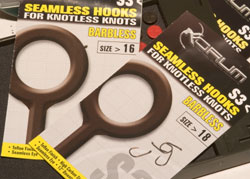 |
| Ian’s hook choice for rudd. |
hook one.
Ian’s rod is coupled with a Shimano Technium MgS 2500, loaded with 0.9mm (2lb 2oz) Preston Reflo Powerline, which offers an unrivalled combination of finesse with strength.
Many anglers view Powerline as a hooklength material, and indeed it is, but it’s also an unbeatable reel line with a diameter which will buy you bites yet not cost you fish. To get your hook bait to mimic a free offering fluttering down through the water requires a gentle touch and a low diameter mono is essential. In very clear water I might fish a fluorocarbon hooklength but in the coloured Frensham water I’m confident to go with the Powerline straight through.
At the sharp end I’m on a barbless Korum S3 in size 18 but I will step up to a 16 if the fish are biting boldly. Rudd can be finicky to start with, but once they begin to feed hard they can lose a lot of their initial caution and I have been known to go up to a size 10 with a large bait when they are really feeding.
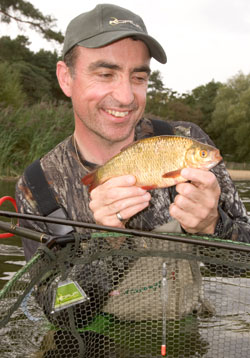 |
Ian’s Top Five Rudd Hook Baits
1 Red Maggots
Few rudd can resist a steady stream of maggots falling through a swim and with a couple of grubs on a size 16 or 18 you should get a bite a chuck. The only downside is they are not size-selective and tiny rudd can grab the bait before the bigger fish get a look in. Feed a 75:25 mix of white and red with red on the hook for best results.
2 Casters
Casters can help to weed out the better fish but, like maggots, they appeal equally to all age classes of rudd. Floating shells can be a terrific way of locating rudd shoals, though; spray them behind the wind, and watch out for rudd coming up and hitting them on top.
3. Sweetcorn
The golden grain is a terrific rudd bait and sinks at a faster rate than maggot or caster if you need to get through the small shoalies. Corn can be sprayed like maggot on a little-and-often basis and will often sort out the better fish. Buy large freezer bags of corn for spraying as a can won’t last long!
4. Bread
Rudd will take pieces of crust off the top and, like floating casters, a few crusts pushing across the lake on the wind will often betray the presence of a shoal. Best of all, though, is a big lump of slow-sinking flake on a size 10 or 12 hook, a classic big rudd catcher.
5. Mini Boilies
Living side by side with carp on most fisheries, rudd have adapted to boilies – and they love ’em! Fast sinking and tough enough to withstand the attentions of the smallest fish, but appealing to the big fish, the mini is a bait you must have in your armoury. Fruit and savoury flavours will both score.
Rudd Or Roach?
Rudd and roach are two species that live happily together, but how do you tell them apart? One simple telltale feature is the mouth – the rudd’s lower jaw protrudes upward and forward of its upper jaw; also the rudd’s dorsal fin is located further back than that of the roach, and the former has golden flanks unlike the roach that is more silver in colour.


